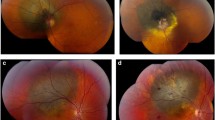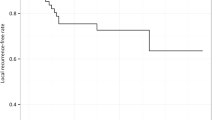Abstract
· Background: Currently available information about survival, local tumor control rates, secondary enucleation rates, and visual acuity following Ru-106/Rh-106 applicator therapy for choroidal and ciliochoroidal melanomas is limited in terms of duration of follow-up among surviving patients. · Methods: The authors performed a retrospective descriptive study of the rates of survival, local treatment failure, secondary enucleation, and visual acuity decrease in 140 patients (141 eyes) with choroidal or ciliochoroidal melanoma treated by Ru-106/Rh-106 applicator radiotherapy between 1964 and 1976. Median follow-up duration among surviving patients in this series was 17.3 years (mean 18.6 years). The Kaplan-Meier method was used to estimate cumulative survival rates and event rate curves. Multivariate Cox proportional hazards modeling was used to identify prognostic clinical variables associated with the various evaluated outcomes. · Results: The 15-year survival rate based on all causes of death was 48.0% (standard error=4.4%), and that based on confirmed and suspected metastatic uveal melanoma was 66.7% (standard error=4.5%). The cumulative 15-year rates of local treatment failure and secondary enucleation were 36.8% (standard error=4.4%) and 34.4% (standard error=4.5%) respectively. The cumulative 10-year rates of visual acuity loss to less than 20/200 and no light perception were 62.8% (standard error=4.4%) and 40.6% (standard error=5.2%) respectively. Prognostic factors associated with death from confirmed and suspected metastatic melanoma were greater tumor diameter and anterior tumor location. Greater tumor diameter was associated with local treatment failure. Baseline visual acuity equal to or worse than 20/200 was associated with profound visual acuity loss. · Conclusions: Although a high proportion of treated eyes eventually lost a great deal of vision, and although many treated eyes ultimately underwent secondary enucleation, a substantial number of patients treated by plaque radiotherapy in this series survived for well over 10 years and retained the tumor-containing eye with a visual decrease of varying severity.
Similar content being viewed by others
Author information
Authors and Affiliations
Additional information
Received: 14 January 1999 Revised version received: 17 May 1999 Accepted: 14 June 1999
Rights and permissions
About this article
Cite this article
Lommatzsch, P., Werschnik, C. & Schuster, E. Long-term follow-up of Ru-106/Rh-106 brachytherapy for posterior uveal melanoma. Graefe's Arch Clin Exp Ophthalmol 238, 129–137 (2000). https://doi.org/10.1007/PL00007880
Issue Date:
DOI: https://doi.org/10.1007/PL00007880




